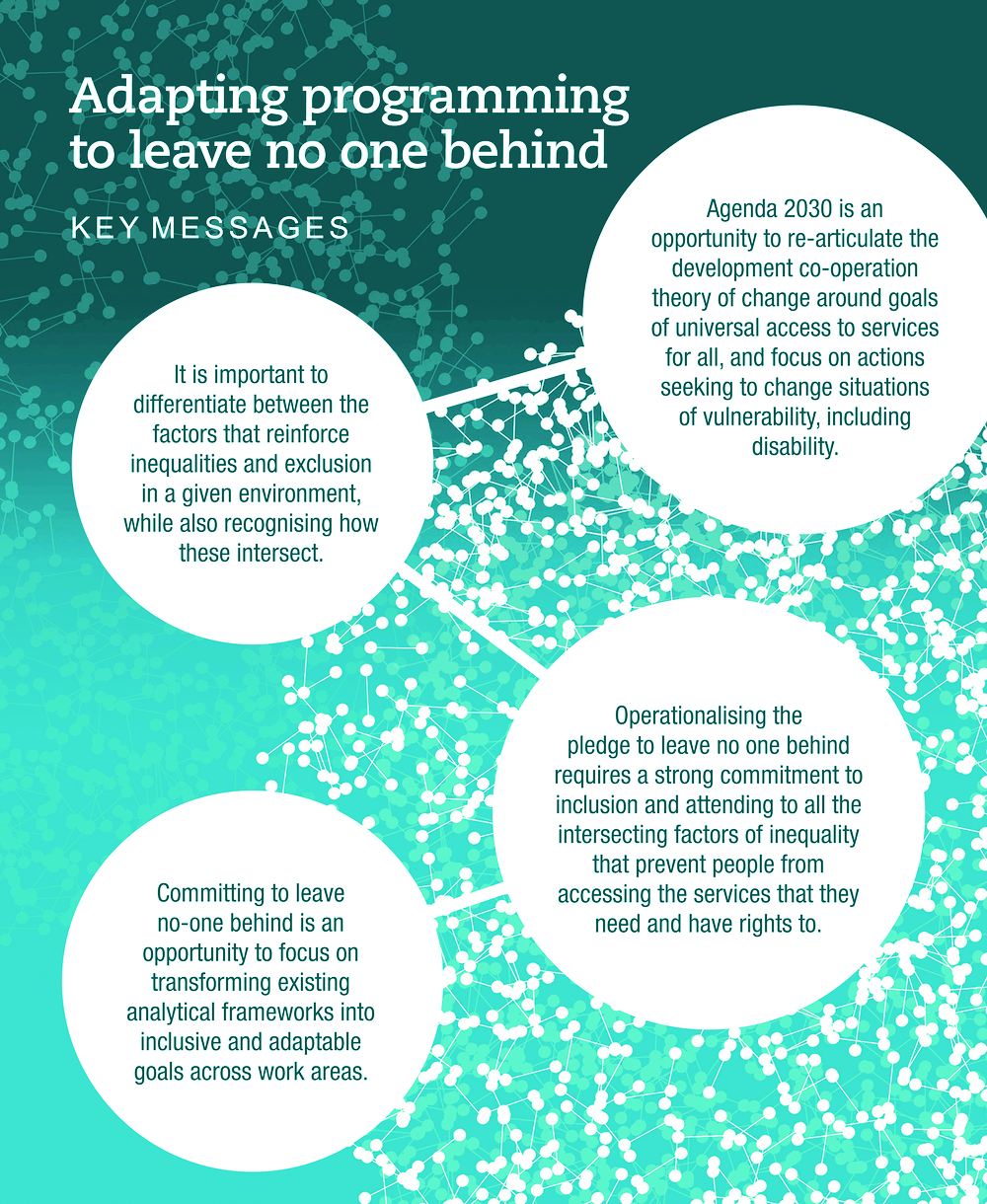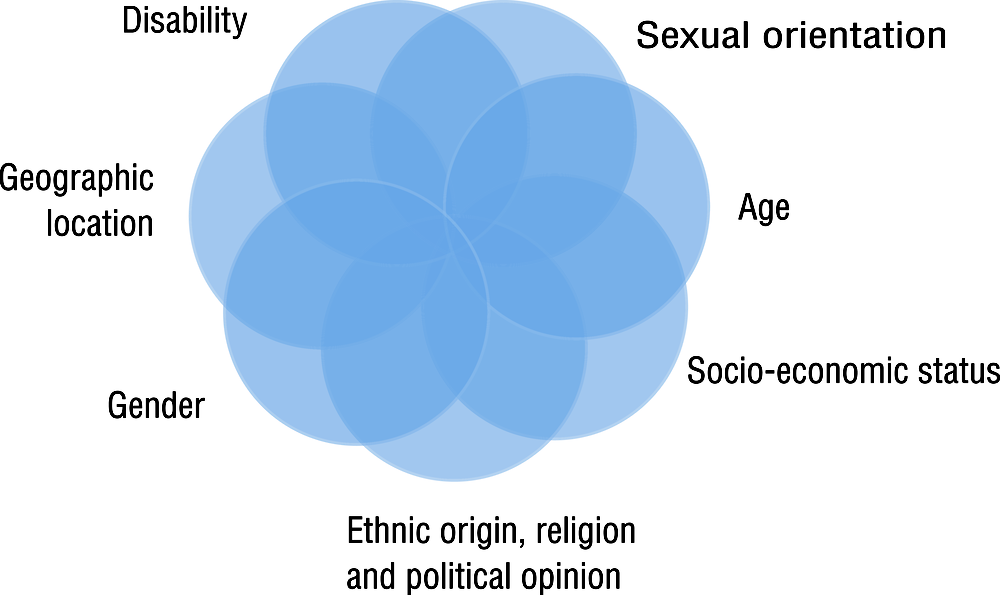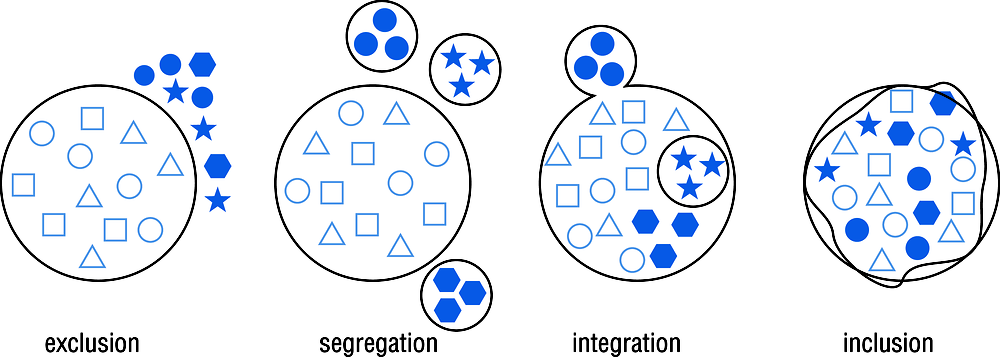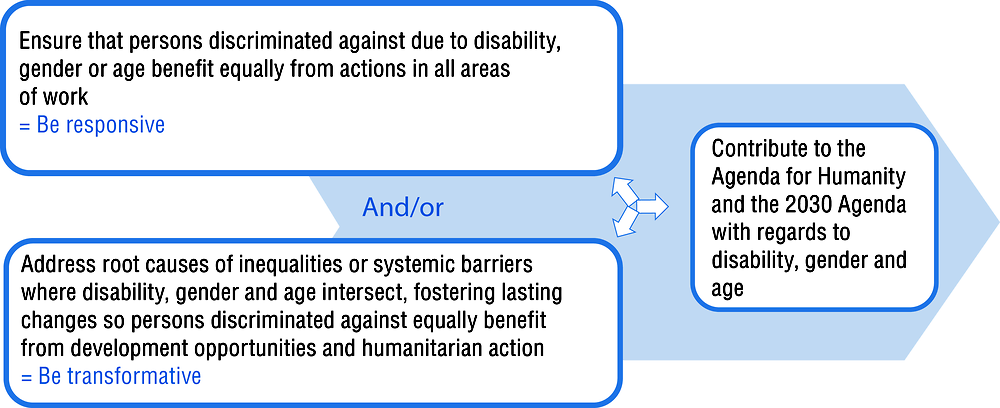Chapter 11. Adapting programming to leave no one behind: Lessons from the NGO Humanity & Inclusion
The commitment to leave no one behind provides an opportunity for all organisations tackling inequality and exclusion to renew their approaches. This chapter reflects the experience of the organisation Humanity & Inclusion – formerly Handicap International – in seeking to operationalise the leave no one behind agenda through more adaptive and evidence based programming. It explains how the commitment to leave no one behind provided a transformative opportunity to develop a new theory of change around the intersecting factors of inequality that reinforce the exclusion of certain people from the services they require. A second step was to develop an analytical framework around the perspective of universal access to services, which serves as a tool to identify how services function and where barriers arise. A third step was to create an Institutional Policy on Disability, Gender and Age, which includes implementation guidelines and markers and drives teams and partners to respond effectively wherever people are left behind due to disability, gender or age.
Growing inequalities between and within countries aggravate the environments that induce exclusion and discrimination. In both emergency situations and in daily life, the most marginalised people are being hit the hardest as they encounter many more barriers – legal, financial, social and attitudinal – to participating in all aspects of society.
With the 2030 Agenda (UN, 2015[1]) and the Agenda for Humanity adopted at the 2016 World Humanitarian Summit (UN, 2016[2]), countries have pledged that development and emergency actions will leave no one behind and effectively reach the furthest behind first. They have promoted inclusion as a means to ensure equal access to fundamental rights for all, and to build strong and sustainable societies. Leave no one behind is a call for an inclusive transformation – a break with exclusionary business as usual.
In 2018, the 35-year-old organisation Handicap International responded to these agendas with a new name and theory of change. Now known as Humanity & Inclusion, it is applying a unique Access to Services Analytical Framework centred on universal access to services. This framework describes the intermediate changes necessary to break down barriers to inclusion, and specifies the types of actions to be implemented, adapted to each setting, sector of intervention and population of concern.
Intersecting barriers to inclusion
Poverty, marginalisation and vulnerability are aggravated when multiple factors intersect. At least nine individual factors reinforce inequalities and exclusion as a result of the perceptions, beliefs and power relations prevalent in a given environment (Figure 11.1). These are disability, age, gender, sexual orientation, socio-economic status, geographic location, ethnic origin, religion and political opinion. The effects of these factors are not the same everywhere; advanced age, for instance, can be a source of legitimacy for exercising authority in some contexts, while in others it can lead to social isolation and marginalisation. As a general trend, however, factors that lead to inequality tend to reinforce each other when they intersect, combining into situations of multiple discriminations, vulnerabilities and exclusions.
The intersecting forms of discrimination experienced by persons with disabilities and other exclusionary factors often also result in significant restrictions to their access to services. These are services to which they are entitled, and which they need to lead dignified and fulfilled lives – or sometimes just to survive. They are resources that are intended to meet all people’s needs in accordance with their fundamental rights, such as health, education, water, sanitation, justice, law enforcement and social services.
Developing a new theory of change: Towards universal access to services
For 35 years, Humanity & Inclusion’s theory of change aimed to respond to the essential needs, improve the living conditions, and promote respect for the fundamental rights and dignity of persons with disabilities and vulnerable populations. Through the focus on the most excluded, leaving no one behind has been an integral but implicit part of the theory of change. By emphasising inclusive policies, strategies and programmes, leaving no one behind becomes more explicit in line with definitions and guidance from the UN Committee on the Rights of Persons with Disabilities (CPRD) (Figure 11.2).1
But we are constantly challenged to do more and better to achieve concrete results and change, including through innovative approaches and learning from successes and mistakes. The 2030 Agenda and Agenda for Humanity provided an opportunity to contribute to a larger more ambitious vision that challenged development and humanitarian organisations like ours to adapt programming and responses to the major changes underway.
To enhance universal access to services we revised our theory of change. Anthropological analysis according to which human development results from interactions between individuals and their environment at micro, meso and macro levels informed the new theory (Brofenbrenner, 1979[4]). The risks of experiencing discrimination or exclusion are indeed greater for certain people, households or communities due to incompatibility between their environment (physical and social) and their unique characteristics, identities, needs and priorities. Such situations reinforce vicious cycles of poverty, and in some cases represent significant risks to people’s lives. Threats that may affect the well-being and the development of people, households and communities can become real causes of impairment, disability and discrimination. These threats include conflicts, injury or trauma, natural disasters, malnutrition, disease (infectious, non-communicable, congenital or chronic), accidents and ageing.
In light of this analysis, we decided to focus actions on the following two situations in which exclusion and discrimination can occur:
-
Situations of vulnerability, referring to significant exposure to one or more types of threat likely to limit or impede the satisfaction of a person’s or a population’s basic needs and access to their fundamental rights, depending on the capacity of these individuals or populations to anticipate, cope or recover.
-
Situations of disability, referring to effective restrictions to people’s participation caused by negative interactions between people with impairment and the environment they live in.
Whether working in situations of vulnerability or disability, HI programmes and actions must relate to people, to their environments, and also, crucially, to the interactions between people and environments. It is therefore essential to analyse the factors that influence these interactions. We do so to bring about changes that will reduce risks, strengthen the capacities of individuals and communities, and remove barriers in their environment, thereby allowing for the full and effective participation of all people in community life, on an equal basis.
Access to services as an analytical framework
To guide our concrete actions towards this vision of full and effective participation in community life for all, with specific attention to the most excluded - persons with disabilities and vulnerable populations – we developed the Access to Services Analytical Framework. This framework also builds on the obligations of countries, as embedded in their commitments to global agendas and to international treaties such as the Convention on the Rights of Persons with Disabilities.2
Drawing on decades of experience operating in more than 60 countries and a diversity of situations, 8 major types of barriers to accessing services for persons with disabilities and vulnerable populations were identified (Box 11.1). In light of these barriers, the analytical framework enables deeper analysis of the functioning of services, and therefore also set the expected results of each envisaged action, with regard to the two important dimensions of governance and service quality (Box 11.2).
Inadequate policies: Policies, if they exist, are not properly implemented, funded or monitored.
Inadequate services: Services, if they exist, suffer from weak capacity of providers and professional staff and diverse obstacles during delivery.
Insufficient involvement and participatory approaches: Persons with disabilities and vulnerable populations are not consulted or sufficiently represented, and do not participate in decision-making processes that concern them.
Negative attitudes: Communities, societies, institutions and even governments stigmatise persons with disabilities and vulnerable populations, adopting negative attitudes and behaviours towards them.
Insufficient and inadequate funding: Funding, including the funding from international co-operation upon which many persons with disabilities and vulnerable populations living in poor countries depend, is insufficient or inadequate to meet their needs and priorities.
Insufficient data: There are not enough data to understand, and help others understand, the situation of persons with disabilities and vulnerable populations and to provide a satisfactory response.
Lack of individual opportunities: Persons with disabilities and vulnerable populations lack access to opportunities that would enable them to acquire the skills and confidence required to actively engage in improving their situation.
Extreme perturbations of the environment: Humanitarian crises, linked to natural disasters or armed conflicts, are the cause of death, injuries, population displacement, infrastructure destruction, or contexts of political tensions or heightened corruption.
By applying, systematically, the same analytical framework to identify the deficiencies of a given system of services and measure where and how to intervene, the coherence of interventions throughout the emergency-rehabilitation-development continuum can be strengthened. The analytical framework allows for operational modalities to differ according to context and seeks to facilitate the transition between chronic crises, emergency response, reconstruction and development. The principle of continuity is a key quality criteria. At the same time, being context specific and capable of adapting to each context is central to achieving access to services for all and the often-ambitious intermediate changes it requires. Careful attention needs to be put into assessing how the nine factors of inequality intersect in different contexts, while paying attention, systematically, to disability, gender and age in particular.
Governance of the services stakeholder system: This is about assessing the consideration given to services at the political level, shown through laws and regulations overseeing service provision, and at the user level, in terms of the demand for services.
-
Decision makers must define strategic orientations and resources enabling access to services for all, evaluate the needs and priorities of users, and guarantee and supervise service provision.
-
Service providers must ensure that the services they provide meet the needs and priorities of their users, and provide expertise for the improvement of the services system.
-
Service users must be able to express demands, needs and priorities in terms of services and an opinion regarding service quality.
Service quality: Quality is assessed through ten criteria:
-
availability
-
participation and participatory approaches
-
non-discrimination
-
accessibility
-
adaptability
-
affordability
-
centred on the person
-
accountability
-
continuity
-
technical quality.
Going one step further in focusing on disability, gender and age
Disability, gender and age are universal determinants that interact with one another to shape the realisation of human rights. They are socially constructed norms that can be observed in any human group, and are key to understanding different people’s capacities, needs and exposure to risks in any context or crisis. They must therefore be systematically taken into consideration, in all contexts. In 2018 we developed an Institutional Policy on Disability, Gender and Age, including implementation guidelines and markers to provide the most innovative and accurate responses to situations of exclusion and vulnerability.
Operationally speaking, the policy establishes a twin-track approach to disability, gender and age equality that focuses on taking actions to end inequalities throughout humanitarian and development work at all levels (including policies and funding), while supporting initiatives to empower the discriminated groups. The key action brought about by this policy is to define the appropriate level of the desired effect. Effects can range from “unaware” of disability gender and age, to “aware/sensitive”, to “responsive”, to “transformative”. HI decided to be, at a minimum, responsive to these factors of inequality in all areas of work, and to be transformative wherever possible (Figure 11.3).
Being responsive in all work areas means systematically developing tailored, pragmatic and innovative solutions to ensure that persons discriminated against on the basis of disability, gender or age benefit equally.
This requires:
-
Strengthening the capacities of persons discriminated against on the basis of disability, gender and age.
-
Strengthening the application of the core guiding principles relating to participation, equality and non-discrimination,3 universal access, and safeguarding.
-
Working with service providers and decision makers to break down the barriers faced by people discriminated against on the basis of disability, gender or age to ensure they can access all services. This means putting in place dedicated measures, including positive action and reasonable accommodation, while strengthening the capacities of decision makers and service providers.
To be transformative wherever possible and relevant means acting on the root causes of inequalities and the systemic barriers where disability, gender and age intersect, and fostering lasting changes so persons who face discrimination benefit equally from development opportunities and humanitarian action (Box 11.3).
The project “Ubuntu Care: Confronting Sexual Violence against Girls and Boys, including Girls and Boys with Disabilities, in Rwanda, Burundi and Kenya” started in 2013. It aims to address the root causes and mitigate the consequences of violence against children, especially those with disabilities.
According to the disability, gender and age marker used by Humanity & Inclusion, the Ubuntu Care project qualifies as responsive to situations of exclusion based on these three factors. Indeed, through the project, girls and boys with disabilities access services. The project is transformative on many levels:
-
It is enhancing the capacities of girls and boys, with and without disabilities, so they can become agents for their own protection.
-
It is strengthening the capacity of local communities to establish their own child protection safety nets.
-
It is building capacity among existing public health, justice, police and education services to conduct multi-disciplinary case management towards assistance and inclusion of survivors, including survivors with disabilities.
-
It is supporting men’s associations that are promoting positive masculinity through campaigns in villages aimed at changing people’s mindsets concerning violence.
Being transformative relies:
-
Empowering persons discriminated against on the basis of disability, gender and age, and their representative organisations, to meaningfully participate and voice their interests, by:
-
building individual capacities, supporting the development of self-confidence, soft skills and social skills and facilitating peer-to-peer support
-
supporting self-representation, local movements and alliances in advocating at local and national levels for policy reforms that realise human rights.
-
-
Strengthening capacities of persons facing discrimination, authorities and policy makers, service providers and international actors to:
-
co-ordinate and improve the governance of a sector or a service, equalising opportunities and proposing responses adapted to needs, strategic interests, capacities and priorities of women and men with disabilities of all ages who face discrimination
-
ensure meaningful participation, equality and non-discrimination, universal access, and safeguarding.
-
-
Influencing and supporting the development of more inclusive policies and practices, and ensure they are monitored on their impact on different groups of people discriminated against. This includes putting in place adequate data disaggregation and participatory mechanisms.
-
Challenging global and local power systems based on and fuelling prejudice and systemic inequalities based on disability, gender and age.
In all cases, an analysis of local contexts, capacities and partnerships should inform programming choices. In certain contexts such as armed conflicts, or when the duration of interventions is short, individual organisations and actors may not have the capacity to enable transformative actions.
To deliver on this new theory of change and policy, Humanity & Inclusion is engaging in a process to adapt projects and programmes to make them, at minimum, responsive to disability, gender and age. We are:
-
strengthening partnerships and all forms of collaboration for disability, gender and age equality
-
strengthening the application of the core guiding principles in all phases in the project cycle and programmatic frameworks: participation, equality and non-discrimination, universal access, and safeguarding
-
ensuring disability-, gender- and age-differentiated analysis in all phases of the project cycle and programmatic frameworks
-
building a strong base of evidence regarding discrimination based on disability, gender and age.
Specific tools also need to be developed to support staff in transitioning to new ways of working so that new operational commitments are delivered in each phase of the project cycle and in programming frameworks. Tools include a disability, gender and age marker, which allows teams to assess whether programmes are unaware, aware, responsive or transformative of these factors. The marker will guide teams to set ambitions about responsive and transformative programming, set time-bound targets, and reflect and learn with regard to disability, gender and age. It will, furthermore, support reflection and learning at the macro organisation level which feeds into and shapes the global focus on disability, gender and age.
Conclusion
There is more to leave no one behind than changing the way development and humanitarian assistance is distributed; it is fundamentally a commitment to inclusion. To operationalise this commitment development and humanitarian organisations, like Humanity & Inclusion, need to change the way they assess and treat exclusion and discrimination. Changes include:
-
attending to all of the intersecting factors of inequality that prevent people from accessing the services they need and have rights to;
-
challenging existing analytical frameworks and assumptions by asking whether these guide actions towards global, and universally inclusive, goals, while being adaptable enough for every context; and
-
breaking down silos between work areas, emphasising a shared commitment to action that responds to, and seeks to transform, the factors that leave so many people behind.
For this, new evidence and data are needed, as well as innovative projects, and funding systems that can adapt to these new requirements. All of these changes are integral to committing to leave no one behind. Operationalising that commitment has transformed our organisation, so that efforts focus more sharply on inclusive human development.
References
Brofenbrenner, U. (1979), The Ecology of Human Development: Experiments by Nature and Design, Harvard University Press, Boston. [4]
CRPD (2016), “General comment No. 4 on the right to inclusive education”, United Nations Human Rights Committee on the Rights of Persons with Disabilities, New York, https://www.ohchr.org/EN/HRBodies/CRPD/Pages/GC.aspx. [3]
UN (2016), Agenda for Humanity: Annex to the Report of the Secretary-General for the World Humanitarian Summit, United Nations, New York. [2]
UN (2015), Addis Ababa Action Agenda of the Third International Conference on Financing for Development, United Nations, New York, http://www.un.org/esa/ffd/wp-content/uploads/2015/08/AAAA_Outcome.pdf. [6]
UN (2015), Transforming Our World: The 2030 Agenda for Sustainable Development, United Nations, New York, https://sustainabledevelopment.un.org/post2015/transformingourworld. [1]
UN (2008), Convention on Cluster Munitions, United Nations, New York. [7]
UN (2006), Convention on the Rights of Persons with Disabilities, United Nations, New York. [5]
UN (2003), “General Assembly Resolution 58/114: Strengthening of the coordination of emergency humanitarian assistance of the United Nations, United Nations, New York, https://undocs.org/en/A/RES/58/114. [8]
UN (1997), Convention on the Prohibition of the Use, Stockpiling, Production and Transfer of Anti-Personnel Mines and on their Destruction, Ottawa, United Nations, New York. [9]
UN (1995), Beijing Declaration and Platform for Action, Beijing, United Nations, New York. [10]
UN (1991), “General Assembly Resolution 46/182: Strengthening of the coordination of humanitarian emergency assistance of the United Nations”, United Nations, New York, http://www.un.org/documents/ga/res/46/a46r182.htm. [11]
UNISDR (2015), “Sendai Framework for Disaster Risk Reduction 2015-2030”, United Nations Office for Disaster Risk Reduction, Geneva, https://www.unisdr.org/we/inform/publications/43291. [12]
Notes
← 1. Humanity & Inclusion placed this core value of leaving no one behind at the centre of its identity when “Inclusion” became part of its new name in 2018.
← 2. Humanity & Inclusion also pays special attention to United Nations General Assembly Resolutions 46/182 and 58/114 on the co-ordination of humanitarian assistance (UN, 2003[8]) (UN, 1991[11]); the Oslo and Ottawa Treaties on cluster munitions and land mines (UN, 2008[7]) (UN, 1997[9]); the Sendai Framework for Disaster Risk Reduction (UNISDR, 2015[12]); the Beijing Declaration and Platform for Action to achieve gender equality (UN, 1995[10]); and the Addis Ababa Action Agenda of the Third International Conference on Financing for Development (UN, 2015[6]).
← 3. A non-exhaustive compilation of international law instruments where inclusion, participation, equality and non-discrimination are considered as regards to gender, age and disability:
Human rights law: Convention on the Rights of Persons with Disabilities (UN, 2006[5]), Articles 9, 11, 19 and 32; Convention on the Rights of the Child, Articles 2, 6, and 23; Convention on the Elimination of All Forms of Discrimination against Women, Article 2; 1951 Convention relating to the Status of Refugees, Articles 3 and 23.
Humanitarian law: Geneva Conventions, Common Article 3; Fourth Geneva Convention, Articles 16 and 17; Additional Protocol I, Articles 75, 76 and 77; Additional Protocol II, Articles 4 and 7.




